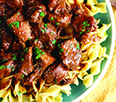January 2019 Farmhouse Kitchen

As the holidays come to a close and life returns to a state of normalcy, if you’re exhausted like me, you start looking for easy, stick-to-your-ribs food to get us through the rest of winter. I love turning to my slow cooker for meals just like this. There’s just nothing like doing a little work in the morning and coming home to the delicious smell of supper ready to eat!
While some folks get a little confused about the difference between a slow cooker and a Crock-Pot, the biggest difference is just the name. Crock-Pot is a brand name for a slow cooker, much like Band-Aid is a brand name for bandages. While some will argue there are some subtle differences, most ceramic crock-based slow cookers and Crock-Pots are fundamentally the same. And the best part is they do all the work for you.
As you’re searching for recipes for your slow cooker, keep in mind that variations in brand and cooking temperatures can sometimes affect the outcome. Here are a few tips to keep in mind as you’re planning out your slow cooker deliciousness.
• Slow cooking involves moist, low heat. As such, many recipes that include a gravy or thick sauce might never thicken properly. To solve that problem, simply mix 1 tablespoon of cornstarch with 1 to 2 tablespoons of cold or room temperature water or broth. Stir the mixture into the slow cooker, and increase the heat to high. Cook for 20 to 30 minutes to thicken the sauce.
• Many slow cooker recipes that call for boneless chicken breasts end up with chicken that is mealy or even dry. That’s because, in most cases, chicken cooked longer than 6 hours, even in the slow cooker, ends up overcooked. I recommend a 4 to 6 hour range for most of my recipes that call for boneless chicken breasts.
• Modern slow cookers cook a bit differently than older models, so oftentimes you might find that older recipes don’t cook the same in newer devices — especially if they have a lot of sugar in the sauce. It’s best to try these types of recipes when you’re going to be around and can check on the progress.
• Don’t peek! Opening the slow cooker before it’s finished cooking allows heat and steam to escape and can require an additional 20 to 30 minutes of cooking time as a result.
• Contrary to popular belief, searing meat before it goes in the slow cooker doesn’t really do anything to “keep the juices in.” While it is a great way to add another layer of flavor if you’ve got time to add that step, I find that skipping it produces food that’s just as delicious without the extra work.
• Make sure you’re using an appropriately sized slow cooker. If a recipe calls for a specific size, it’s probably best to follow that suggestion. Using a slow cooker that’s too large can cause dishes be overcooked, while one that’s too small may mean things don’t get cooked through appropriately. Your slow cooker should be 1/2 or 2/3 full. I find most recipes work best in a 5- to 6-quart slow cooker.
